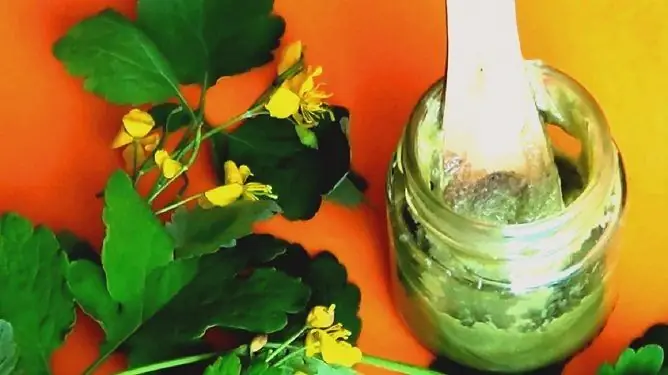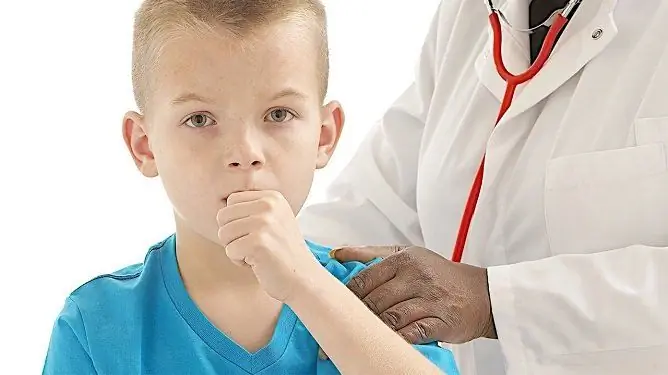- Author Rachel Wainwright [email protected].
- Public 2023-12-15 07:39.
- Last modified 2025-11-02 20:14.
How to treat bronchitis in an adult at home: treatment with traditional and folk remedies
The content of the article:
- Treatment of bronchitis in adults at home
- How to additionally treat chronic bronchitis in adults at home
- How to additionally treat acute bronchitis in adults at home
- Prevention
- Overview of bronchitis
- Video
To treat bronchitis in an adult at home can be very effective if you follow all the doctor's recommendations. Hospitalization in the pulmonology department is indicated for patients with a severe course of the disease, for example, with the development of obstructive syndrome and respiratory failure, and in the absence of the effectiveness of therapy, which is carried out at home.
Bronchitis accounts for about 90% of the total number of all diseases of the respiratory system. With timely diagnosis and properly selected treatment, bronchitis can usually be eliminated in 1.5-3 weeks. With inadequate therapy or its absence, there is a risk of the disease becoming chronic and / or developing other complications.
Bronchitis should not be carried on the legs, even if the patient is feeling well. It is recommended to stay at home for at least the first week, but it is advisable to stay on sick leave for 2 weeks. In this case, it will be possible to create optimal conditions for the body to fight the disease.

Treatment of bronchitis should not be carried out on your own, without a doctor
The main treatment of bronchitis can be supplemented (but not replaced!) With folk remedies, but they should be used in the same way as pharmaceutical medicines, only after agreement with the attending physician. Chronic and acute bronchitis in adults at home can be treated with the same folk remedies, however, chronic therapy is longer.
Treatment of bronchitis in adults at home
It is necessary to use any medication for bronchitis only after consulting your doctor. The best therapeutic effect for bronchitis is provided by complex therapy.
With an increase in body temperature, antipyretics are prescribed.
With bronchitis of bacterial etiology or complicated by the addition of a secondary infection, antibiotics are prescribed, which must be taken in strict accordance with the doctor's prescriptions, without abandoning the course immediately after relief comes.
In the case of the development of the disease against the background of a viral infection, immunostimulating drugs can be used, if microscopic fungi are detected - antimycotic drugs.
To improve the discharge of sputum, mucolytic, expectorant drugs are used. For the same purpose, as well as to reduce inflammation, inhalations with saline, soda solutions, essential oils (pine, eucalyptus, peppermint, rosemary), infusions and decoctions of medicinal herbs can be prescribed. Essential oils and herbs should be used with caution by people prone to allergies. It should also be borne in mind that hot steam inhalation is contraindicated in acute bronchitis, so they are carried out using a nebulizer.
The room in which the patient is located should be humidified. It is best to do this with an automatic air purifier and humidifier.
Patients are shown an abundant drinking regimen (1.5-2.5 liters per day) and a gentle, balanced, easily digestible food. Recommended are mint, linden, chamomile tea, a decoction of wild rose, raspberries, cocktails from mineral water, milk and honey, fruit drinks and compotes from fruits and berries, tea with lemon.
In the absence of signs of acute inflammation (i.e., with chronic bronchitis in remission and with recovery after acute), therapeutic massage and breathing exercises are indicated.
How to additionally treat chronic bronchitis in adults at home
- Compresses of honey and mustard (contraindicated at elevated body temperature). For a compress, mix 2 tablespoons of honey and the same amount of mustard powder, spread the mass on a dense cloth and place it on the chest, cover it with polyethylene and a towel or scarf on top, hold it for about 30 minutes. With a strong burning sensation, the compress should be removed earlier. The next day, the compress is placed on the back. The treatment continues for 8 days (1 time per day), alternating the place of setting the compress.
- Horseradish compress. The horseradish root is rubbed on a fine grater, spread in a layer about 1 cm thick on the back in the bronchial region, after which the mass is covered with a cloth. The patient is left to lie with a compress for 10 minutes. If the burning sensation is very strong, remove the mass before the specified time. If the procedure is well tolerated, it should be carried out once a day for 10 days.
- Rubbing with a mixture of turpentine and vegetable oil. Mix turpentine with vegetable oil in a 1: 1 ratio. The resulting mixture is rubbed on the back and chest 2 times a day (morning and evening), after that the patient needs to lie under a warm blanket for an hour. Cotton clothing should be worn during the procedure. If the patient complains of severe burning, turpentine with oil should be mixed in a 1: 2 ratio.
- Cabbage juice. Squeeze juice from cabbage and drink 50 ml (you can add honey) 3 times a day for 10 days.
- Decoction of licorice root. To prepare the product, 2 tablespoons of the plant are poured with a glass of boiling water and placed in a water bath for 20 minutes. After that, the broth is covered with a towel, left to cool completely and filtered. Take a tablespoon 4 times a day until the symptoms of the disease disappear.
- Infusion of marshmallow root. To prepare the product, a tablespoon of raw materials is poured with a glass of boiling water, insisted in a thermos for an hour and filtered. The infusion is consumed in a tablespoon 4 times a day, regardless of food intake, for 10-20 days.
- Infusion of thyme. A tablespoon of the plant is poured with a glass of boiling water and insisted for 6 hours in a thermos. The finished product must be filtered and drunk 2 tablespoons 3 times a day for two weeks.
To increase immunity in chronic bronchitis, you can drink decoctions of horsetail, birch, violet, yarrow, lingonberry leaves, and also use licorice root syrup, natural mummy.

For bronchitis, drink plenty of fluids
How to additionally treat acute bronchitis in adults at home
- A mixture of black radish and honey is one of the most popular folk remedies for acute bronchitis. One large radish should be thoroughly washed (without peeling the peel), cut off the upper part, cut out a part of the pulp from the middle. A teaspoon of honey is placed in the resulting depression, covered with the cut off top and left for 2-3 hours. During the specified time, the radish will let the juice in which the honey will dissolve. The mixture should be poured into a glass and the radish can be refilled with honey. The agent is taken in a tablespoon 3-4 times a day after meals.
- Plantain infusion is a good expectorant. 50 g of dry herb plantain pour 500 ml of boiling water, insist in a thermos for 2 hours, strain and take a tablespoon 15 minutes before meals for 1.5-2 weeks.
- Onion expectorant. Thoroughly wash a large onion (without peeling it off), add water so that it covers the onion by no more than 1 cm, add 10 tablespoons of sugar to the water and put on fire. Cook under a tightly closed lid for 30 minutes, let cool, then remove the onion from the liquid. Divide the broth into 4 servings to be drunk per day. Treatment continues for 7 days.
- Horseradish and lemon mixture. To prepare the product, rub 150 g of horseradish on a fine grater and mix with the juice of 3 lemons, leave for 30 minutes. The remedy is taken in a teaspoon, washed down with tea and honey, once a day for 10 days.
- Sage and milk remedy. For its preparation, a tablespoon of sage herb is poured with 1 glass of milk and boiled for 1-2 minutes. After that, the agent is removed from the heat, allowed to cool, filtered and drunk warm before going to bed. Sage milk should be taken for 2 weeks to eliminate inflammation and fight coughs.
- A decoction of tangerine peel, effective for purulent impurities in sputum. 5 tablespoons of fresh or dried tangerine zest is poured into 500 ml of water and boiled for an hour. After that, the broth is insisted for another 2 hours, covered with a towel, filtered and taken 1 tablespoon 3 times a day for a week.
- Aqueous infusion of chamomile, calamus, calendula, sage. To prepare the product, a tablespoon of any of the listed medicinal plants is poured with a glass of boiling water, infused for an hour and drunk 3 times a day.
For bronchitis, folk remedies based on coltsfoot, thermopsis, as well as breast collection, anise drops are often used.
Prevention
In order to prevent the development of bronchitis, it is necessary to quit smoking, eat right, be in the fresh air for at least an hour a day, improve immunity, avoid long-term stay in places with severe air pollution, treat colds in a timely manner, avoid industrial hazards, stressful situations, do not sleep less than 8 hours a day.
Patients who have undergone bronchitis are shown spa treatment.
Overview of bronchitis
Bronchitis is a disease in which there is inflammation of the bronchial mucosa with increased production of phlegm. The secreted mucus provokes the development of coughing attacks, which is necessary to clear the airways of phlegm. The disease can be acute or chronic. Bronchitis occurs in all age groups. Bacteria, viruses, microscopic fungi can be an infectious agent in bronchitis. Most often, bronchitis develops against the background of influenza or acute respiratory viral infections, when the mucous membrane of the bronchi is involved in the pathological process.
Risk factors for the development of bronchitis include smoking, frequent stressful situations, surgical interventions, hypothermia, the presence of industrial hazards, infectious diseases of viral etiology transferred on the legs, the presence of a chronic inflammatory process in the nasopharynx, and oral diseases. At risk are people who are allergic to substances that enter the body through the respiratory tract. Bronchitis can also develop when a number of chemicals are inhaled.
With bronchitis, the general condition of the patient usually deteriorates sharply over several hours. Patients complain of increasing weakness and increased fatigue, decreased performance, increased sweating, severe cough (at first dry, then wet), pain in the chest, wheezing, shortness of breath. If the disease has developed as a complication of ARVI, nasal congestion, discharge from the nasal cavity, sore throat may be observed. Body temperature in patients with bronchitis rarely rises to febrile values (38 ° C and above), usually it does not exceed 37.5 ° C.

The temperature in patients with bronchitis usually does not rise above subfebrile values
If you find symptoms of bronchitis, you should immediately consult a doctor. This is especially true for people with a history of chronic lung disease, since this category of people has a high risk of developing severe, complicated forms of the disease. Treatment of such patients may require hospitalization.
If bronchitis is suspected, X-ray examination, laboratory blood tests, sputum are performed. In some cases, bronchoscopy is indicated.
Against the background of bronchitis, in the absence of adequate treatment, the patient may experience acute respiratory failure, pneumonia, bronchopneumonia, tracheitis, bronchial asthma, chronic obstructive pulmonary disease, pulmonary heart failure, pulmonary emphysema, pulmonary hypertension.
Video
We offer for viewing a video on the topic of the article.

Anna Aksenova Medical journalist About the author
Education: 2004-2007 "First Kiev Medical College" specialty "Laboratory Diagnostics".
Found a mistake in the text? Select it and press Ctrl + Enter.






